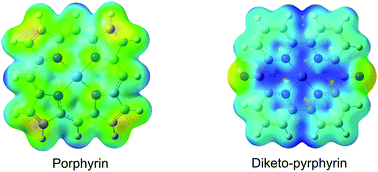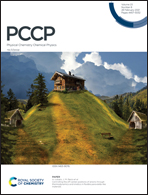Theoretical modeling of the singlet–triplet spin transition in different Ni(ii)-diketo-pyrphyrin-based metal–ligand octahedral complexes†
Abstract
The structural stability, charge transfer effects and strength of the spin–orbit couplings in different Ni(II)–ligand complexes have been studied at the DFT (B3LYP and CAM-B3LYP) and coupled cluster (DLPNO-CCSD(T)) levels of theory. Accordingly, two different, porphyrin- and diketo-pyrphyrin-based four-coordination macrocycles as planar ligands as well as pyridine (or pyrrole) and mesylate anion molecular groups as vertical ligands were considered in order to build metal–organic complexes with octahedral coordination configurations. For each molecular system, the identification of equilibrium geometries and the intersystem crossing (the minimum energy crossing) points between the potential energy surfaces of the singlet and triplet spin states is followed by computing the spin–orbit couplings between the two spin states. Structures, based on the diketo-pyrphyrin macrocycle as the planar ligand, show stronger six-coordination metal–organic complexes due to the extra electrostatic interaction between the positively charged central metal cation and the negatively charged vertical ligands. The results also show that the magnitude of the spin–orbit coupling is influenced by the atomic positions of deprotonations of the ligands, and implicitly the direction of the charge transfer between the ligand and the central metal ion.

- This article is part of the themed collection: Quantum Theory: The Challenge of Transition Metal Complexes


 Please wait while we load your content...
Please wait while we load your content...